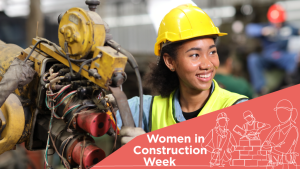Choosing a career path as a youth can be intimidating at the best of times.
Panellist Clarice Ward, project manager, specialty projects with Melloul-Blamey Construction, likened it to a “tidal wave coming at you.”
“The social and cultural expectations in our society, it’s a very powerful thing,” Ward told a virtual audience during Skills Ontario’s Parent/Guardian Skilled Trade & Technology Information Series recently.
“You hear messaging, ‘go to college,’ ‘go to university’ which isn’t bad advice.
“There is additional messaging that the trades are only for certain types of people, messaging that it’s not necessarily for women…The good news is, parents they can have a powerful impact in encouraging their daughters to do this.”
Ward said she has seen a lot of change over her 15-year career in the evolution of careers in construction for everyone.
“You can be in the skilled trades for a reason, a season or a lifetime,” she said. “There are opportunities to enter management as well as time progresses. There is a lot to think about when you are entering such a big business and the construction industry itself is just a massive industry.”
Raly Chakarova, executive director of the BOLT Charitable Foundation, echoed her comments.
“There is a huge diversity, which is great because everybody should feel empowered that they have a lot of choice and that there is a career path for everybody,” Chakarova said.
She told students to think about construction trade careers in terms of the stages involved in constructing a building.
“A good way of thinking about it is thinking about the stages of construction, so during excavation what that looks like,” she explained. “During the framing, or what we call the forming trades, that’s your cement finisher, your rebar work, your crane operators, your spotters on the ground. Then you move over to putting that building together, the drywall trades, the internal systems like the HVAC and the sheet metal workers and then plumbers and electrical. Then you have your sprinkler fitters and fire protection technician.”
With women making up only 4.5 per cent of the skilled trades, Ward explained the issues are attracting, retaining and advancing females in the industry.
Reducing barriers to women entering the trades requires a multi-pronged approach which includes setting the record straight and trying to dispel the stereotypes that exist, said Amina Dibe, manager, government and stakeholder relations at the Residential Construction Council of Ontario.
“If you’ve only heard bad things about careers in the trades or construction you are not going to consider that career path in the first place,” she said. “We need better promotion, not just to youth but their influencers: parents, guidance counsellors, teachers, people that have a really big impact on a young person’s career journey. I also think that employers need to be more flexible especially in this day and age where it is very much a jobseekers market.”
Mentorship is also important, she added.
“We talk about mentorship a lot as it relates to retention. I think we should be talking about it as it relates to recruitment as well, starting mentorship as early as possible.”
One of the best ways to challenge the stigma and the stereotypes is through promoting what is actually true and promoting the diversity that is becoming part of the industry, said Jessica Gemmell of the IBEW, Local 804.
“Showing women and people of colour on the advertising is one of the ways I think we can get around the stereotype of the more uneducated, male construction worker that is quite prevalent out there still,” she said.
Health and safety standards have come a long way from the photos of the construction workers eating lunch on a metal beam several storeys above the city, added Chakarova.
“With our youth programming and when we place our youth with employers the first questions always is, ‘do they have their working at heights and do they have their hazardous material safety certification,’ ” she said. “Without that they can’t work.
“Health and safety is also a really growing field for a job in terms of demand. You have individuals, their entire job is to walk the site and make sure every worker there is abiding by the safety restrictions and are staying safe.”
Follow the author on Twitter @DCN_Angela.











If our youth enjoy daily freezing cold or steamy sweaty summer days, layoffs when the project is complete, travelling all over Ontario, trying to find affordable housing, and of course dirty filthy working conditions and the net result of being covered from head to toe with dust and dirt, the jobsite noise and wearing uncomfortable safety gear along with the onsite safety issues that can cripple or kill a worker in minutes and of course health issues such as carpel tunnel and long term arthritis and back disc injury, it is golden and I would not trade a day on any jobsite that I was on that put food on the table with a beer, bought me Harleys, Boats and my fully owned home along with vacations in most of europe and the caribbean, it is Golden !